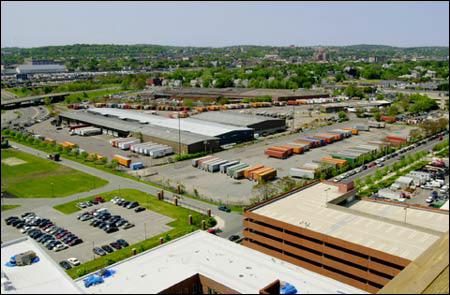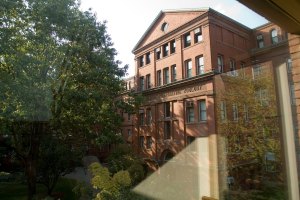Looking into Harvard’s future:
Planning for tomorrow in Allston

At first glance, it is hard to see a campus on the 110 undeveloped acres that Harvard owns in North Allston. The parking lots, warehouses, and industrial sites are evidence that there is much groundwork to be done. Officials say it could take years, if not decades, before a new campus can be fully realized. Still, there has been an enormous amount of activity in the last year centered around planning and analyzing data and opinion from across the University. Through these efforts the University hopes to inform a decision on how to design and build an Allston campus.
The planning hinges on some challenging questions: How much space will Harvard need generations from now? Can Harvard anticipate the next developments in science and technology or new disciplines yet to be discovered and also anticipate how Allston can help fulfill Harvard’s needs in those areas? How does Harvard best integrate its expanded presence in Allston with the Allston community? How might the Cambridge campus be changed or enhanced in the process?
“The decisions about what we do in Allston will say something about what Harvard is a century from now, and it is a profoundly important set of choices, not only for us, but for the city of Boston and the community of neighbors that will benefit with us,” said President Lawrence H. Summers.
“Allston is a remarkable gift that we have been given, the opportunity to build a new campus, aligned with the campus we already have, to meet the very large challenges that lie ahead for our University. With so much at stake and so much potential, it is much more important to choose wisely than to choose rapidly.”
Planning and visioning for the future
This has been a year marked by University-wide planning. To coordinate the processes, the University Physical Planning Committee has met monthly over the past year. They have engaged faculty and administrators in discussions about potential academic uses in Allston, as well as the challenges inherent in developing land that is not yet zoned for institutional use.
At the same time, individual schools have been preparing reports projecting their space needs 20 years from now. For example, the Law School created a Locational Options Committee chaired by Professor (future dean of the Law School) Elena Kagan. The committee evaluated the pros and cons of moving to Allston. They studied various ways of achieving the Law School’s objectives in their current precinct as well as in potential Allston campuses.
Faculty advisory committees
Also during this period, faculty committees convened by Provost Steven E. Hyman met to think through how Allston could satisfy the University’s aspirations in science, graduate, and professional schools, housing, and the arts and culture. “These advisory groups have made a great contribution and have helped us in understanding and exploring these opportunities in Allston,” said Hyman.
Some 50 faculty members and administrators participated in four advisory groups. Three groups were asked to focus on one of three general scenarios for Allston: one in which science departments and scientific research were at the heart of the new academic community; a scenario in which one or more graduate and professional schools were the principal constituents; and a scenario in which arts, culture, and museums would be an important component of the campus, though not its sole focus. A fourth group, reporting to Sally Zeckhauser, the vice president for administration and comprised of deans, deans of students, faculty, and other staff, focused on the development of housing in Allston under any of the scenarios.
Over the course of the fall and winter, these advisory groups met regularly to suggest both principles to guide the development of an Allston campus and also a few specific ideas for the new campus. They were charged to think creatively and to offer multiple concepts that the University community and its leaders could use in formulating more specific proposals and plans.
The three groups agreed on many of the same principles and came to many similar conclusions about an Allston campus. First, they agreed that Harvard’s land in Allston presents an intellectual opportunity: It should not be understood simply as a pressure valve for Cambridge – an Allston campus should enable the University to take advantage of academic synergies, encourage collaboration across disciplinary and institutional boundaries, and create the physical conditions in which new ideas and new fields are most likely to develop.
Second, the advisory groups shared the view that Allston should be a diverse campus incorporating academic functions, housing, arts and culture, and commercial activities. It should be lively during the day and at night and should address the needs of researchers, students, and members of the larger community.
Third, participants believed strongly that Allston presents Harvard with an opportunity to conduct its business differently. Allston enables the University, for example, to develop shared facilities. Cafeterias, study rooms, perhaps even teaching spaces, might be shared across schools and departments. Savings might result, but, as important, new relationships – among students, faculty, staff – might emerge.
Finally, all of the advisory groups agreed that the new campus must be tightly integrated with the existing campus. Movement between the two should be as simple and rapid as possible.
Based on these principles, the advisory groups suggested specific relationships that might be enhanced by physical proximity in a new campus. The advisory group on graduate and professional schools noted that a significant number of Harvard’s graduate schools share a commitment to providing aspiring leaders with management and leadership skills. Several of these same schools also study areas of public policy that overlap with one another. They noted that a campus that brought together some grouping of such schools would be a campus rich with opportunities for collaboration and sharing of expertise.
The graduate schools group also speculated about a campus that could bring together the School of Public Health with certain life science departments of the Medical School and the Faculty of Arts and Sciences. The science advisory group considered such an option more carefully and noted that areas like systems biology, neuroscience, bioengineering, and computational biology are essentially interdisciplinary and would benefit from closer proximities among the collaborators.
The arts, culture, and museums advisory group pointed out that Harvard’s collections could benefit from shared state-of-the-art storage space in Allston. Shared exhibition space would encourage co-curation of shows and thus would represent an important intellectual benefit of proximity among museums. Performing artists – both student and professional – meanwhile, would welcome the availability of new performing venues. Most exciting, perhaps, is the possibility of cross-disciplinary art: Dialogue among different media, art forms, and genres is the source of much of today’s most interesting work.
The advisory group on housing looked carefully at the housing supply and demand at the University with a particular focus on graduate students and junior faculty. The group’s most important observation was that it is important for the University to achieve the goal of housing at least 50 percent of its graduate students.
Planning by the Allston Initiative
A parallel physical planning process managed by the Allston Initiative, a new department created this year, is also under way. The Allston Initiative is working with consultants who have technical expertise in transportation and land use and land development, and other areas. These consultants have helped the University understand how to make Allston more connected to Cambridge by describing, for example, various transportation possibilities to link Allston to Cambridge. They have also studied the convertibility of buildings in Cambridge and what that would mean for growth in Allston.
“We are faced with a finite amount of space in Cambridge. We know Allston will allow Harvard to fulfill its academic and research mission generations from now,” said Kathy Spiegelman, director of the Allston Initiative. “With this land we have the opportunity to strengthen Harvard as an institution by helping integrate Harvard academically, logistically, and socially.”
Working with the Allston community
While Harvard’s internal planning processes have been taking place, the Allston community has also begun to plan for the arrival of a new academic campus. For many months members of the community have been in discussions with representatives of Mayor Menino’s staff, city agencies, and the University. Recognizing the importance that this move will have to the Allston community, the University has been working hard with both elected officials and civic leaders to find common ground for future development.
Kevin McCluskey, Harvard’s director for community relations in Boston, sees the community process informing and strengthening Harvard’s own internal planning effort, with proposed improvements in streetscape, the enhancement and creation of more open space, and increases in housing.
Neighborhood residents who have been a part of the process agree that there is a potential for a “win-win.”
“With Harvard anticipating building out space for academic programs, we have to expect and look at how that might change the character of the neighborhood. We are looking at how that change might be brokered to preserve the natural diversity of this community,” said Ray Mellone, chair of the planning committee and lifelong resident of Allston.
Provost Hyman said, “With this land we have the opportunity to strengthen Harvard for generations to come. The good work done this year by faculty, staff, and others in the University community has laid a strong foundation for advancing this enormously important and complicated process.”
Recent Allston purchase
As the Gazette goes to press, Harvard has finalized the purchase of 91 additional acres in Allston from the Massachusetts Turnpike Authority. This purchase will help ensure that the University can meet the long-term needs of future generations. There are no current plans for this most recent purchase.




